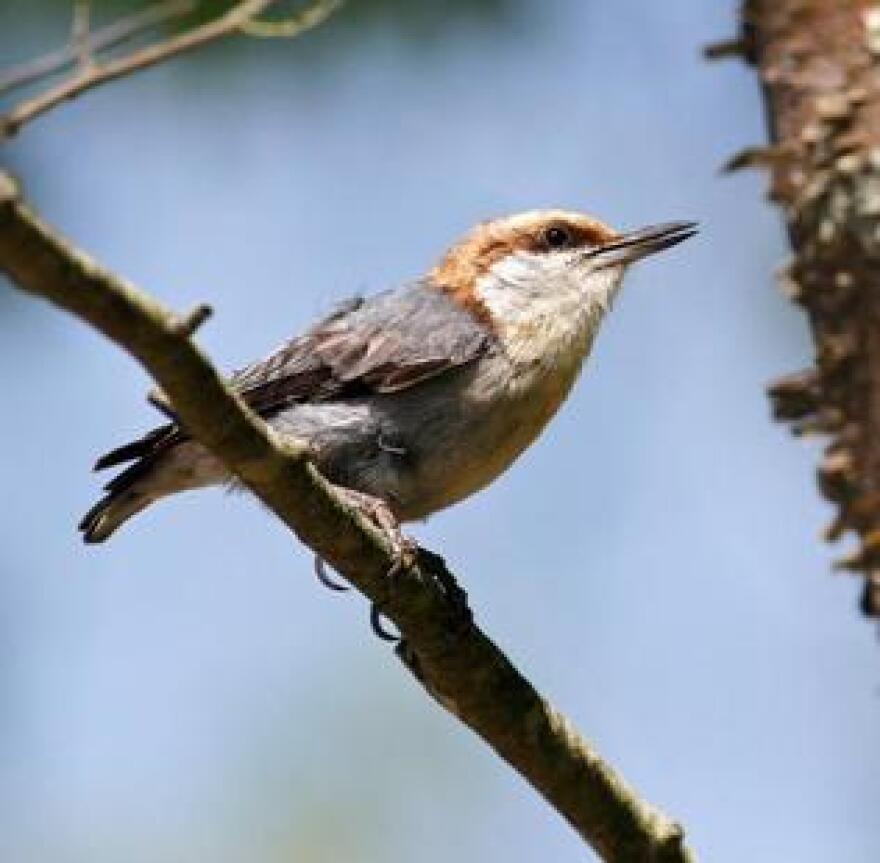Human progress has not been kind to either the Eastern bluebird or the brown-headed nuthatch.
The bluebirds lost their homes in fence posts to large-scale farming. Logging and development took the mature pines where the nuthatches lived in cavities and ate pine seeds and pine-dwelling insects.
But a large human cheering section has brought the bluebirds back from the brink as thousands of nest boxes were erected during the past several decades.
“People who love bluebirds really love bluebirds,” said Mark Stanback of Davidson College. To study bird behavior, he and his students erected hundreds of nest boxes in Pinehurst and the greater Charlotte area over the past 15 years.
There are probably more bluebirds now than there have ever been, he said, and probably half the 4,000 golf courses in the Southeast have boxes.
The nuthatches (Sitta pusilla) have received no such outpouring of support.
Getting its food in trees, the brown-headed nuthatch is not a familiar sight around backyard feeders. The bird’s coloring – blue-grey backs, brown heads and white chins – lacks the dazzle of bright blue and rose.
And those birds are tiny, weighing less than an ounce and are about one-third a bluebird’s size.
Federally listed as a species of concern, brown-headed nuthatches have dwindled to about 160,000 to 175,000 adult breeding birds in North Carolina, said Curtis Smalling, director of land bird conservation for Audubon North Carolina.
There are 1.2 million bluebirds in the state, he estimated.
The situation is most noticeable in the Piedmont crescent from Charlotte to Raleigh, where rapid development holds sway, Smalling said. Nuthatch numbers there have dropped at around 3 percent a year the past decade, a 20 to 30 percent decline overall, he said.
Neighborhood menace

To make things worse, the bluebirds are kicking nuthatches out of nest boxes.
“They vocalize. They chase,” Stanback said of the larger birds.
If a nuthatch gets to a box first and starts nesting, “the bluebird will go in and refuse to come out,” Stanback said.
And if there are two boxes and the bluebird can use only one, he’ll keep the nuthatch out of the vacant one.
An evicted nuthatch family, said, Stanback, “will sit outside and just squeak and squeak.”
After years of hearing the squeaks of evicted nuthatches, Stanback decided to see if bluebirds might be a contributing cause of the decline.
He started retrofitting some of the nest boxes he’d put up by reducing the entrance hole from 1 1/2-inchs to 1 inch.
“Suddenly, I got nuthatches,” he said.
And the birds kept coming. By last year, when he was putting up small-hole boxes specifically for nuthatches, he got a 74 percent nuthatch occupancy rate in 110 boxes on Pinehurst golf courses.
Twenty-one percent of the occupants were similar-sized Carolina chickadees, who pose no competition for the nuthatches as long as there are plenty of boxes. “They can coexist,” he said.
Not only did the nuthatches flock to the boxes, but the birds flew in the face of conventional thinking by coming to bluebird-proof boxes in pine-poor areas.
Nuthatches preferred them to those in pine-rich areas that carried a threat of bluebird competition, leading Stanback to conclude that they “don’t need to be in pristine forest. As long as they have some pines, they do OK.”
Taking action

Stanback’s findings, partially funded by the U.S. Golf Association’s Turfgrass and Environmental Research Program, were published in that organization’s online newsletter.
Acting on his findings, Audubon NC in late 2013 embarked on a “save the nuthatch” campaign, asking individuals, golf clubs, parks, scouting and other groups to retrofit or erect new boxes to provide 1-inch entrance holes.
They hope to have 10,000 up by the start of 2015. “That’s a lot of boxes,” Smalling admitted. “But we’re close to 2,000 boxes right now.”
It couldn’t happen to a nicer bird, Stanback said.
He remains a fan of bluebirds. “They may be bullies,” but unlike the house sparrow, who will kill over a box, “They’re not over the top,” he said.
Nevertheless, “You don’t have to be colorful to be an attractive bird.
“The squeaky-toy, rubber-ducky call that nuthatches make, it’s really endearing,” he said.
If I had a hammer
And nuthatches are one of the few birds known to use tools. The birds can grasp small pieces of bark in their beaks to use as hammers to chip away a tree’s bark to uncover the insects beneath.
Unlike woodpeckers, who will back down a tree trunk, nuthatches clamber down headfirst.
An entire extended family will live in one box, with grown males sticking around to help their parents raise succeeding generations.
If you have nuthatches in your yard, Stanback said, “You can see this whole family of birds flying around.
“They’re very special. They’re there year-round so you get to know them very well.”
Learn how to attract more birds to your yardhere.

